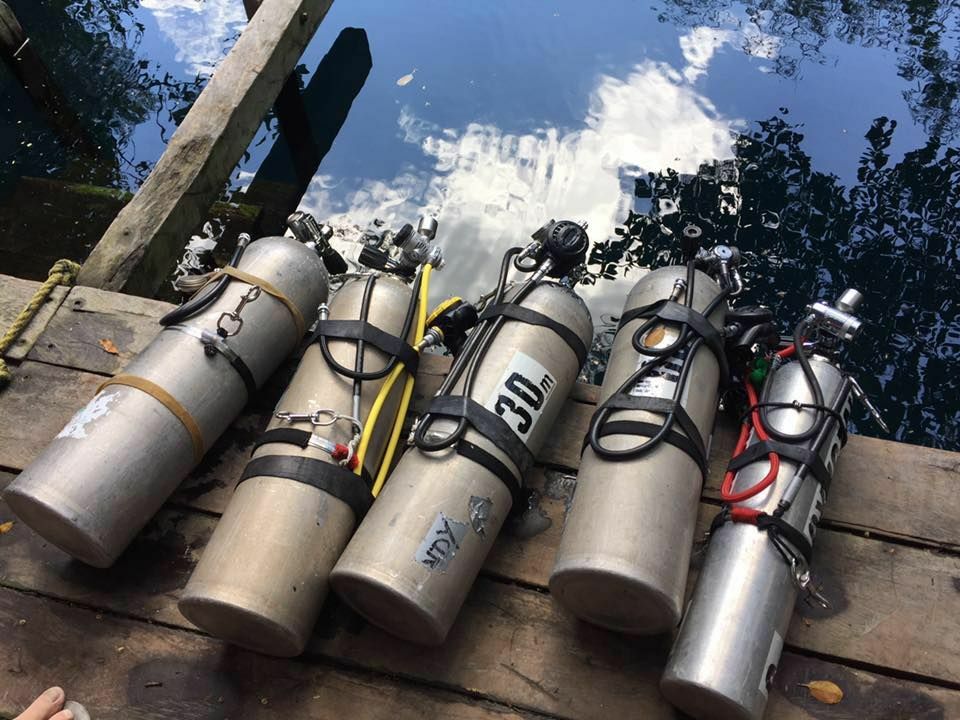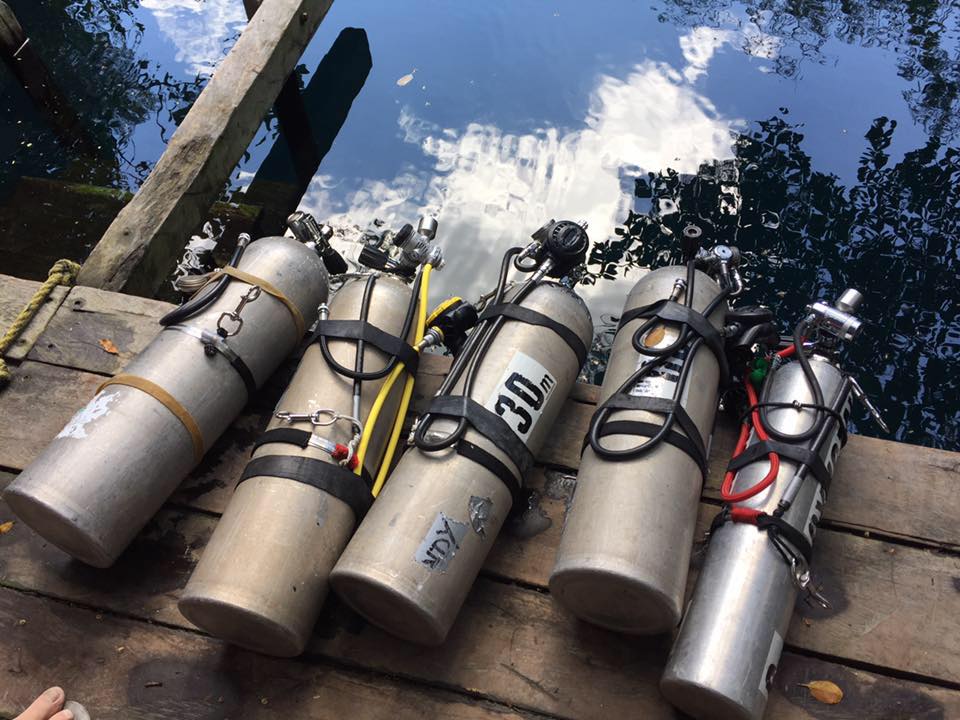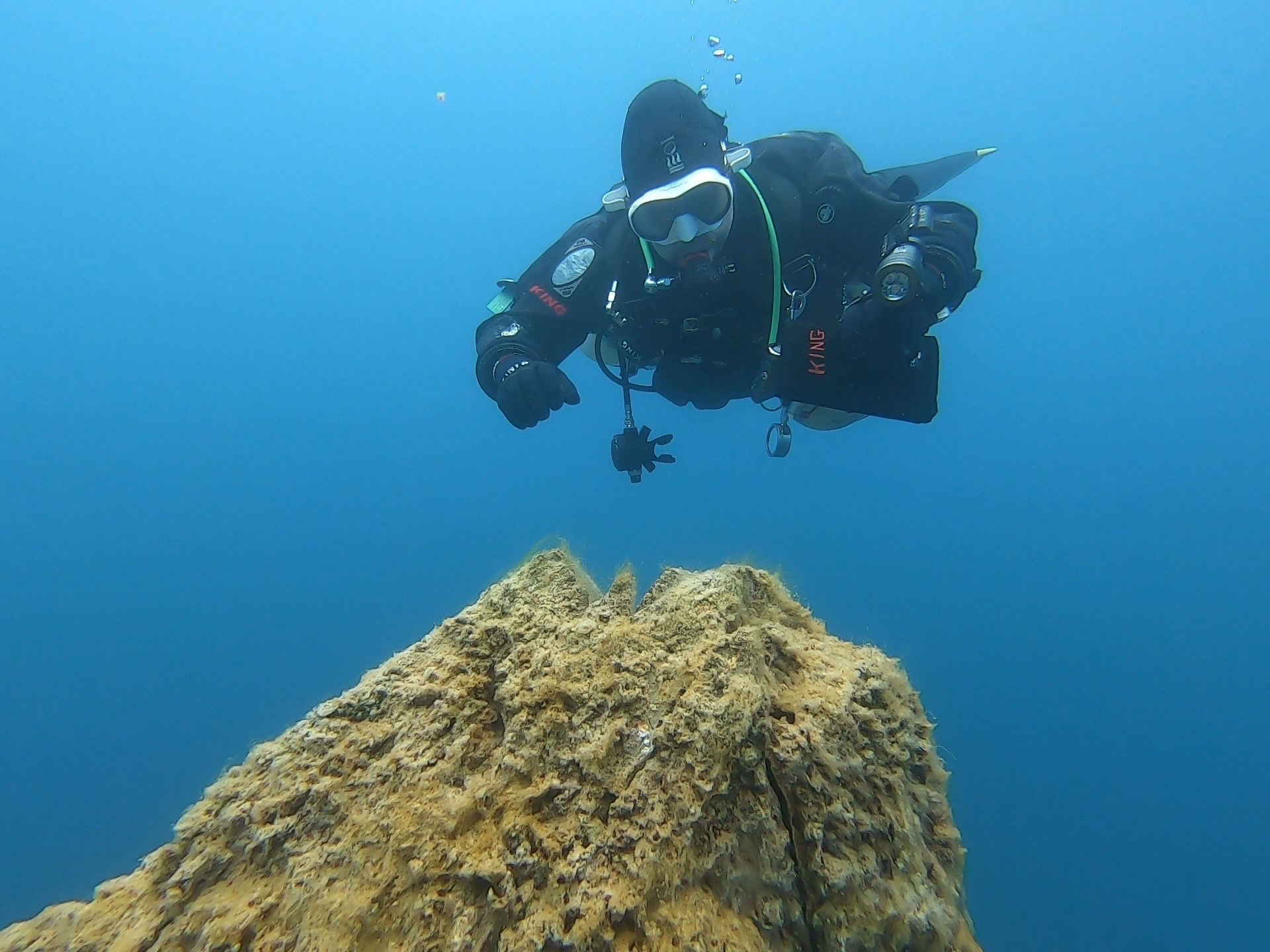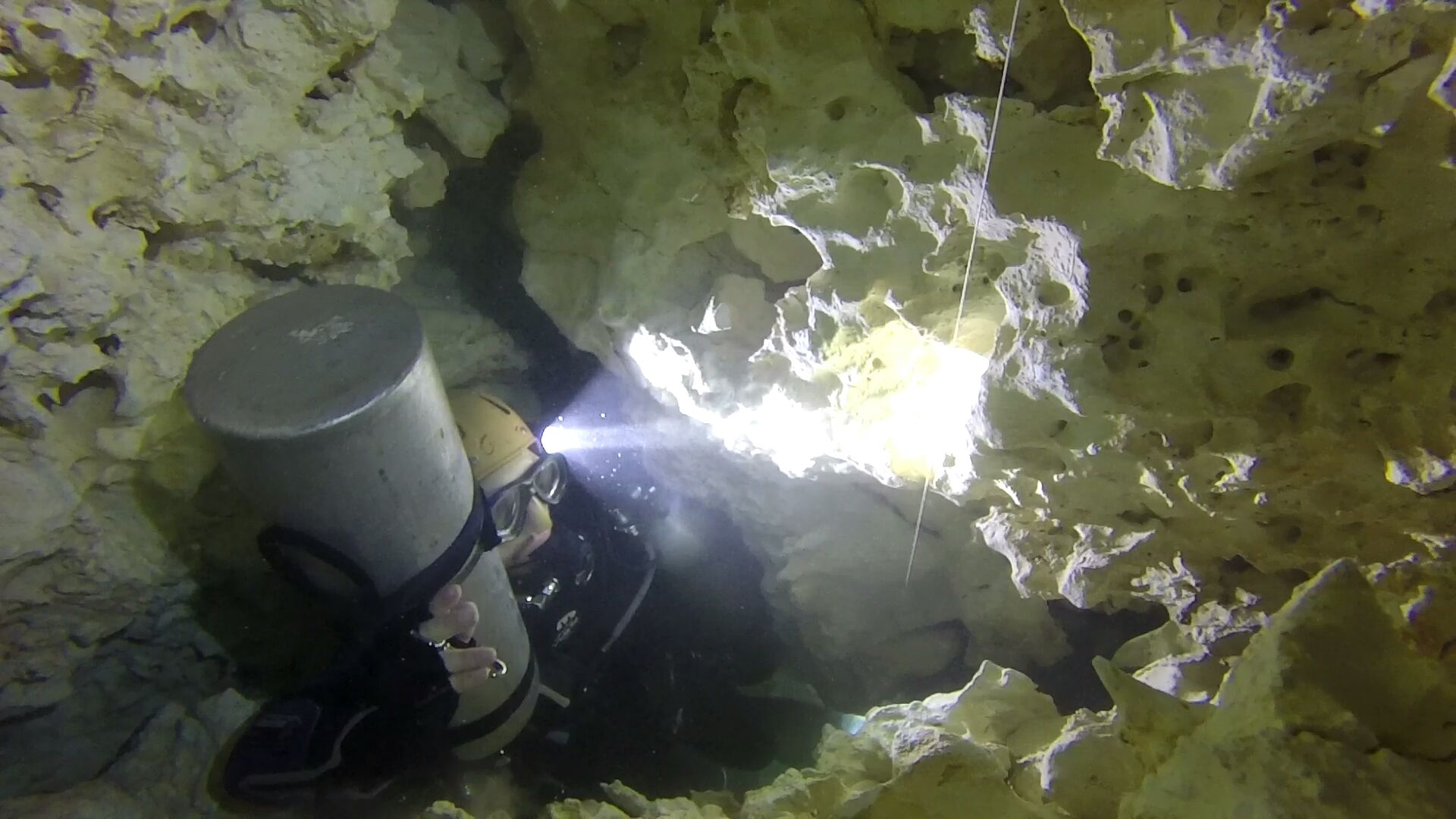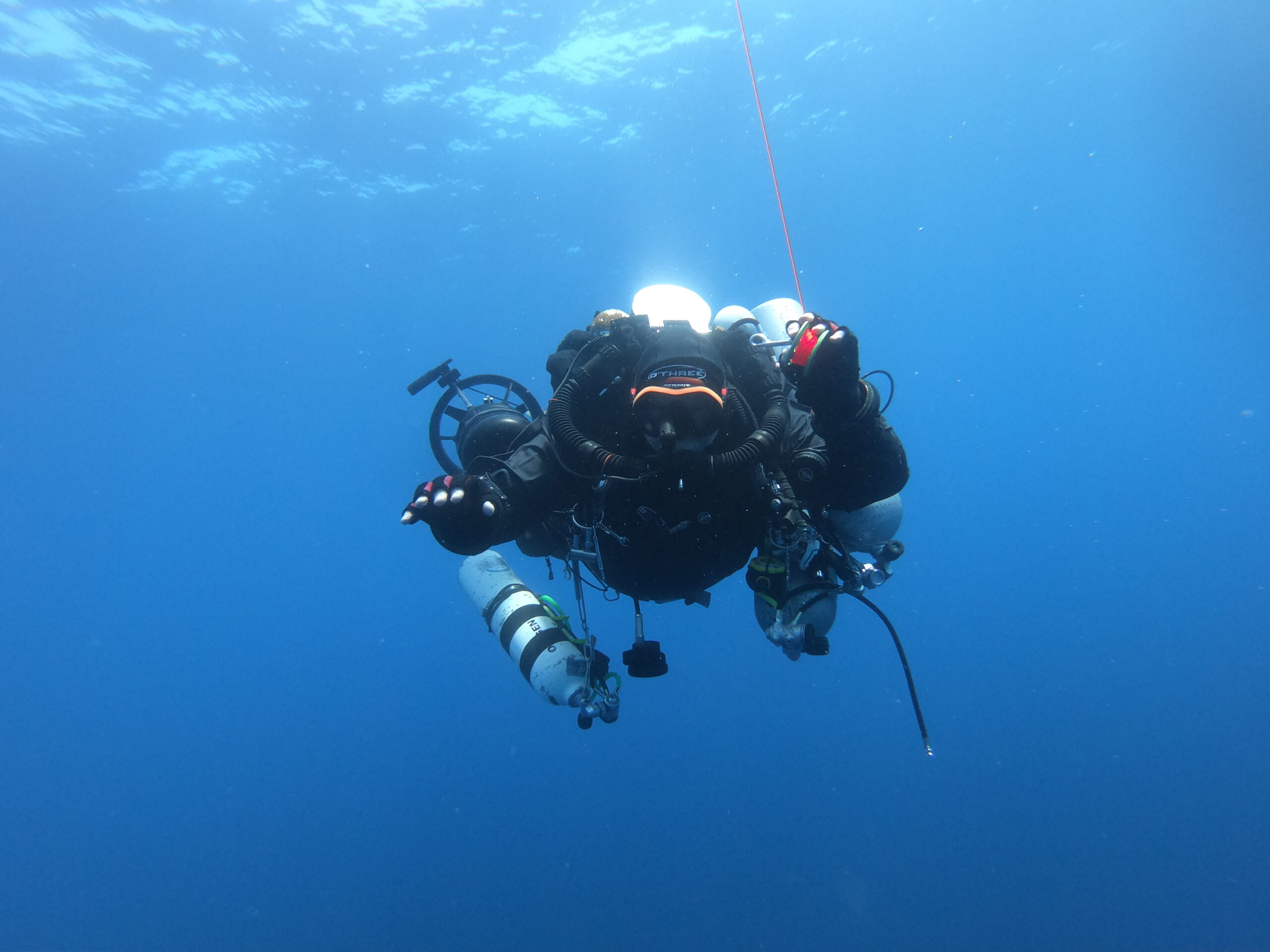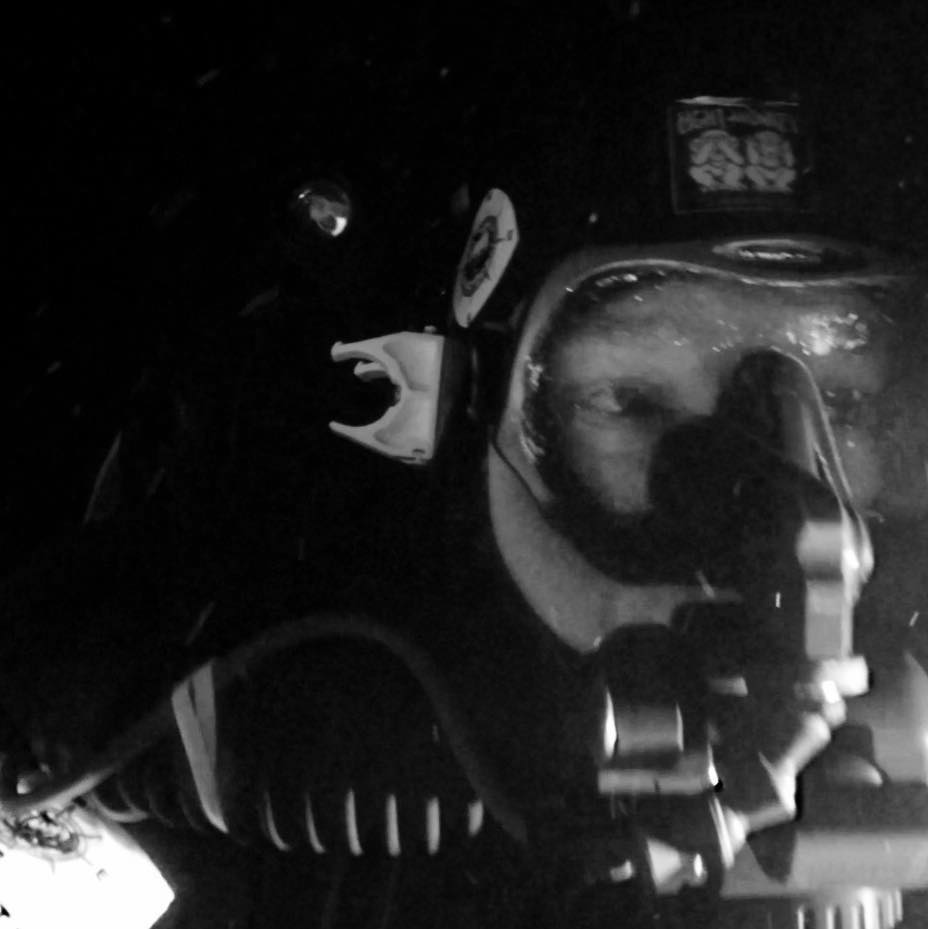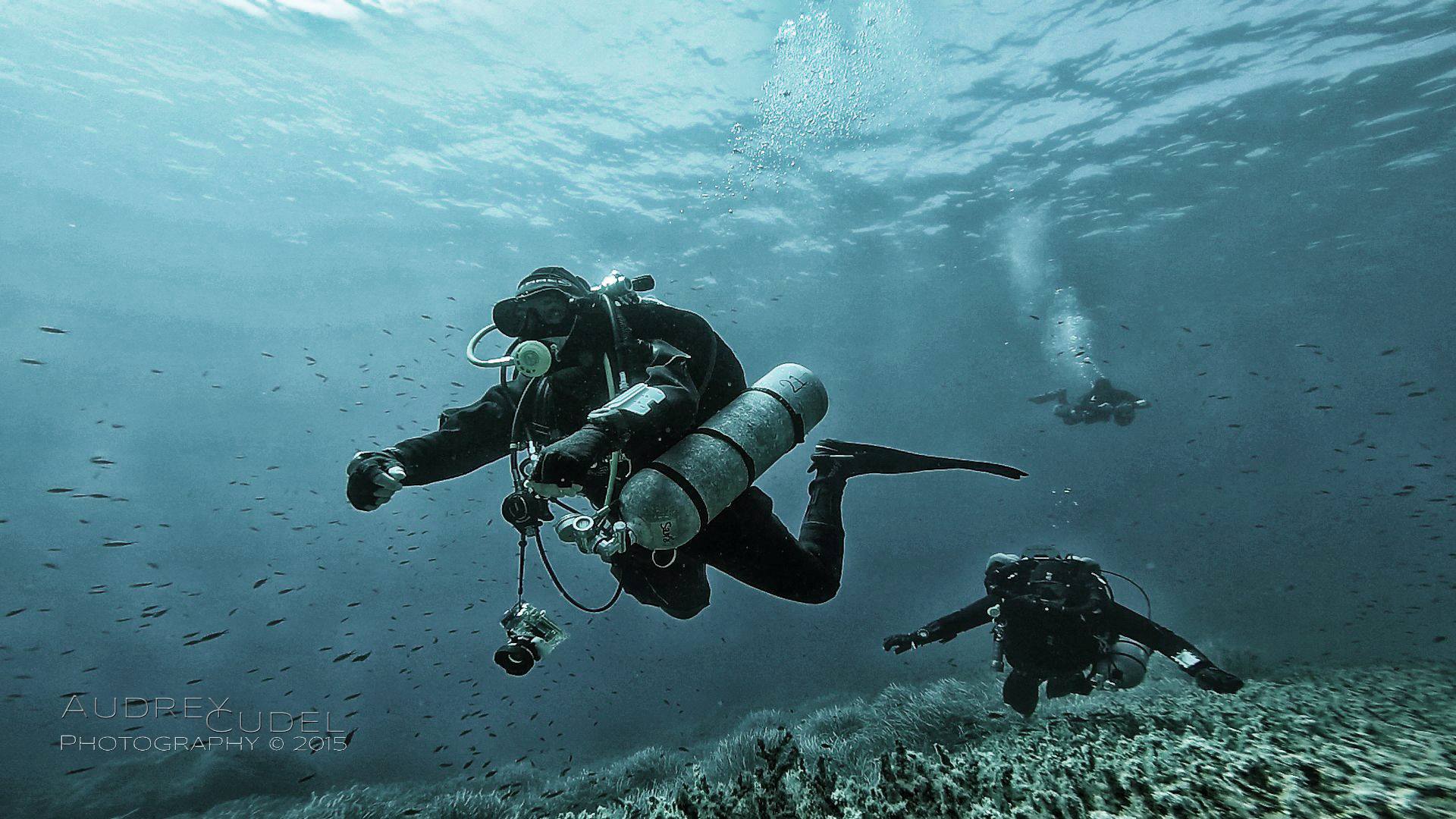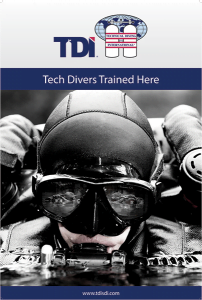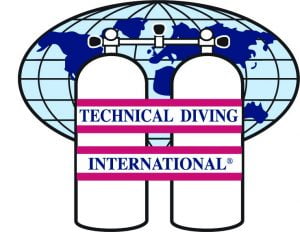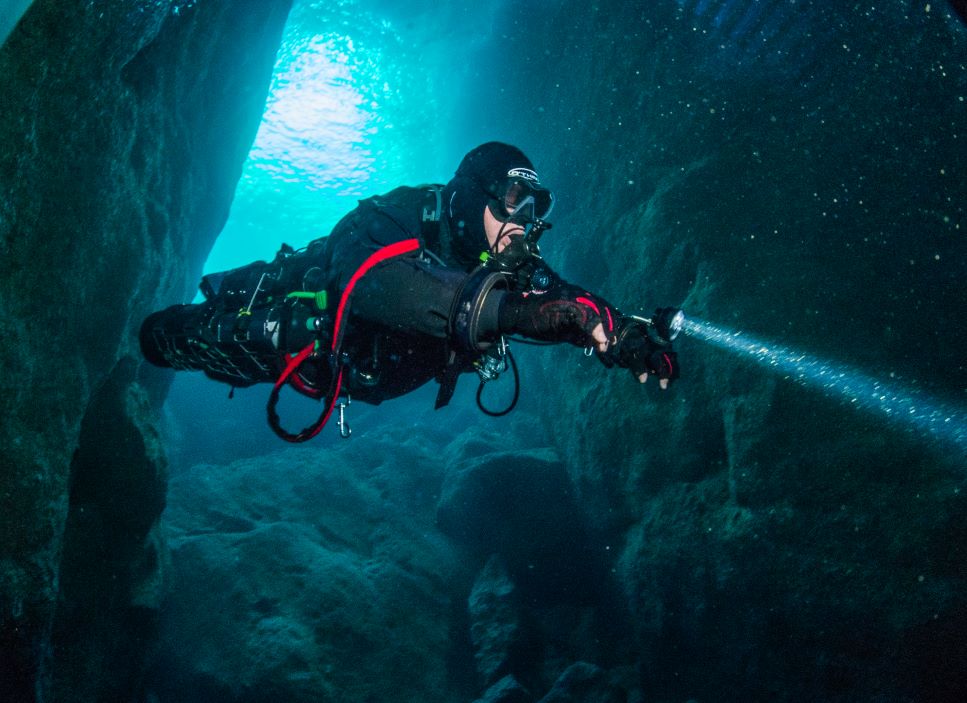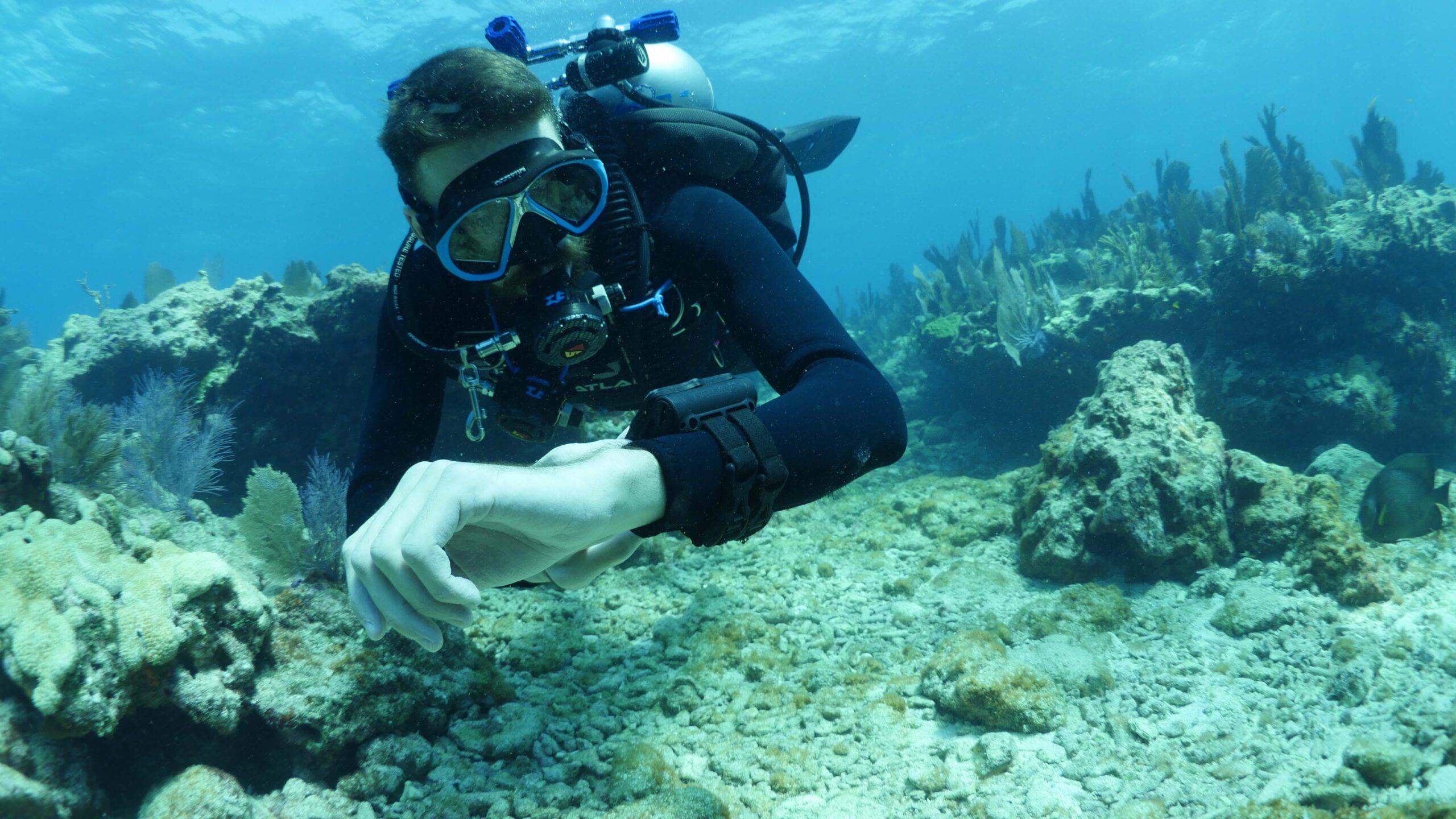Stage Rigging
We get asked a lot about stage rigging, both for open circuit decompression, for cave stages and for CCR bailout. There are three main schools
Traditional
Stage rigging kit, top boltsnap on the shoulder of the cylinder, lower boltsnap on jubilee band, all boltsnaps attached by cord. Cylinder is quick and easy to remove, hand off etc, but a PITA for positioning, hangs like a clanging bell, or floats, often at 90 degrees to body. Not our preferred way.
Image shows typical traditionally rigged position
Sidemount Style
So a traditionally valved cylinder, but rigged with the top boltsnap on a bungee choker, bottom boltsnap on bungee through a jubilee clip, no handle. This allows, if top to bottom boltsnap distances are correct, a tension that stabilises the cylinder and lets it sit much straighter.
Image shows typical traditionally rigged position on divers right, sidemount style on left
Fully Sidemounted
A modular valve with an extension post is used on the cylinder and a bungee looped rigged to the divers backplate/harness. The allows a proper sidemount style mounting and gives a very streamlined position along the side of the body.
Image shows full sidemount position
The various cylinders below show different rigging, all to be used on the same dive. It’s all practically fully interchangeable, especially if you use a safety loop on a full sidemount style so a double ender can be used as top clip in the event of a handoff to a non sidemount loop equipped diver.
We are very used to all styles as different environments and the availability of different kit when we travel doesn’t always allow for a purist approach. Good and well educated divers can make any of these work for them.
Get in touch to let us help you choose and configure your stage set-up to your preferred and most appropriate way.
Matt
Matt Jevon, M.Sc. F.IoD is a Full Expedition level Trimix and Cave instructor on OC and CCR with TDI and ANDI. He is the JJ-CCR and Divesoft Liberty Sidemount instructor and dealer for Ireland. Matt’s personal diving has included cave exploration in the Philippines, wreck projects in Croatia and Ireland as well as being one of the inaugural dirty dozen in Truk! Matt has held accreditations as an interdisciplinary sports scientist, sports psychologist with BASES and was a British Olympic Registered Strength and Conditioning Coach and invitee on the Olympic Psychology Advisory Group. Matt works in high performance business as a board advisor and non-exec, high performance sport and is a partner in South West Technical Diving in Ireland. www.swt.ie and writes the Facebook page Psychological Skills for Diving
#tdidivecentre #andifacility #Apekstechnicalcentre #caveinstructor #jjccrfactoryservicecentre #JJCCR #ANDI #nolimitsexploration #cavediving #Apeks #divesoft #sidemountccr #southwestech #nautilus #othree90ninety #divemorepostless #xdeep #TDI #technicaldiving #scaleolights #rebreathers #seacraft #kubidrygloves #sidemountessentialsinstructor #sidemountccr #libertyccr #jjccr_official #wedontsellwhatwedontdive #nobubbles #diving #deepdive #techdiving #technicaldiving #ccrdiver #underwater #trimix #wreckdiver #cavediver
Stage Rigging
We get asked a lot about stage rigging, both for open circuit decompression, for cave stages and for CCR bailout. There are three main schools
Traditional
Stage rigging kit, top boltsnap on the shoulder of the cylinder, lower boltsnap on jubilee band, all boltsnaps attached by cord. Cylinder is quick and easy to remove, hand off etc, but a PITA for positioning, hangs like a clanging bell, or floats, often at 90 degrees to body. Not our preferred way.
Image shows typical traditionally rigged position
Sidemount Style
So a traditionally valved cylinder, but rigged with the top boltsnap on a bungee choker, bottom boltsnap on bungee through a jubilee clip, no handle. This allows, if top to bottom boltsnap distances are correct, a tension that stabilises the cylinder and lets it sit much straighter.
Image shows typical traditionally rigged position on divers right, sidemount style on left
Fully Sidemounted
A modular valve with an extension post is used on the cylinder and a bungee looped rigged to the divers backplate/harness. The allows a proper sidemount style mounting and gives a very streamlined position along the side of the body.
Image shows full sidemount position
The various cylinders below show different rigging, all to be used on the same dive. It’s all practically fully interchangeable, especially if you use a safety loop on a full sidemount style so a double ender can be used as top clip in the event of a handoff to a non sidemount loop equipped diver.
We are very used to all styles as different environments and the availability of different kit when we travel doesn’t always allow for a purist approach. Good and well educated divers can make any of these work for them.
Get in touch to let us help you choose and configure your stage set-up to your preferred and most appropriate way.
Matt
Matt Jevon, M.Sc. F.IoD is a Full Expedition level Trimix and Cave instructor on OC and CCR with TDI and ANDI. He is the JJ-CCR and Divesoft Liberty Sidemount instructor and dealer for Ireland. Matt’s personal diving has included cave exploration in the Philippines, wreck projects in Croatia and Ireland as well as being one of the inaugural dirty dozen in Truk! Matt has held accreditations as an interdisciplinary sports scientist, sports psychologist with BASES and was a British Olympic Registered Strength and Conditioning Coach and invitee on the Olympic Psychology Advisory Group. Matt works in high performance business as a board advisor and non-exec, high performance sport and is a partner in South West Technical Diving in Ireland. www.swt.ie and writes the Facebook page Psychological Skills for Diving
#tdidivecentre #andifacility #Apekstechnicalcentre #caveinstructor #jjccrfactoryservicecentre #JJCCR #ANDI #nolimitsexploration #cavediving #Apeks #divesoft #sidemountccr #southwestech #nautilus #othree90ninety #divemorepostless #xdeep #TDI #technicaldiving #scaleolights #rebreathers #seacraft #kubidrygloves #sidemountessentialsinstructor #sidemountccr #libertyccr #jjccr_official #wedontsellwhatwedontdive #nobubbles #diving #deepdive #techdiving #technicaldiving #ccrdiver #underwater #trimix #wreckdiver #cavediver
Stage Rigging
We get asked a lot about stage rigging, both for open circuit decompression, for cave stages and for CCR bailout. There are three main schools
Traditional
Stage rigging kit, top boltsnap on the shoulder of the cylinder, lower boltsnap on jubilee band, all boltsnaps attached by cord. Cylinder is quick and easy to remove, hand off etc, but a PITA for positioning, hangs like a clanging bell, or floats, often at 90 degrees to body. Not our preferred way.
Image shows typical traditionally rigged position
Sidemount Style
So a traditionally valved cylinder, but rigged with the top boltsnap on a bungee choker, bottom boltsnap on bungee through a jubilee clip, no handle. This allows, if top to bottom boltsnap distances are correct, a tension that stabilises the cylinder and lets it sit much straighter.
Image shows typical traditionally rigged position on divers right, sidemount style on left
Fully Sidemounted
A modular valve with an extension post is used on the cylinder and a bungee looped rigged to the divers backplate/harness. The allows a proper sidemount style mounting and gives a very streamlined position along the side of the body.
Image shows full sidemount position
The various cylinders below show different rigging, all to be used on the same dive. It’s all practically fully interchangeable, especially if you use a safety loop on a full sidemount style so a double ender can be used as top clip in the event of a handoff to a non sidemount loop equipped diver.
We are very used to all styles as different environments and the availability of different kit when we travel doesn’t always allow for a purist approach. Good and well educated divers can make any of these work for them.
Get in touch to let us help you choose and configure your stage set-up to your preferred and most appropriate way.
Matt
Matt Jevon, M.Sc. F.IoD is a Full Expedition level Trimix and Cave instructor on OC and CCR with TDI and ANDI. He is the JJ-CCR and Divesoft Liberty Sidemount instructor and dealer for Ireland. Matt’s personal diving has included cave exploration in the Philippines, wreck projects in Croatia and Ireland as well as being one of the inaugural dirty dozen in Truk! Matt has held accreditations as an interdisciplinary sports scientist, sports psychologist with BASES and was a British Olympic Registered Strength and Conditioning Coach and invitee on the Olympic Psychology Advisory Group. Matt works in high performance business as a board advisor and non-exec, high performance sport and is a partner in South West Technical Diving in Ireland. www.swt.ie and writes the Facebook page Psychological Skills for Diving
#tdidivecentre #andifacility #Apekstechnicalcentre #caveinstructor #jjccrfactoryservicecentre #JJCCR #ANDI #nolimitsexploration #cavediving #Apeks #divesoft #sidemountccr #southwestech #nautilus #othree90ninety #divemorepostless #xdeep #TDI #technicaldiving #scaleolights #rebreathers #seacraft #kubidrygloves #sidemountessentialsinstructor #sidemountccr #libertyccr #jjccr_official #wedontsellwhatwedontdive #nobubbles #diving #deepdive #techdiving #technicaldiving #ccrdiver #underwater #trimix #wreckdiver #cavediver
